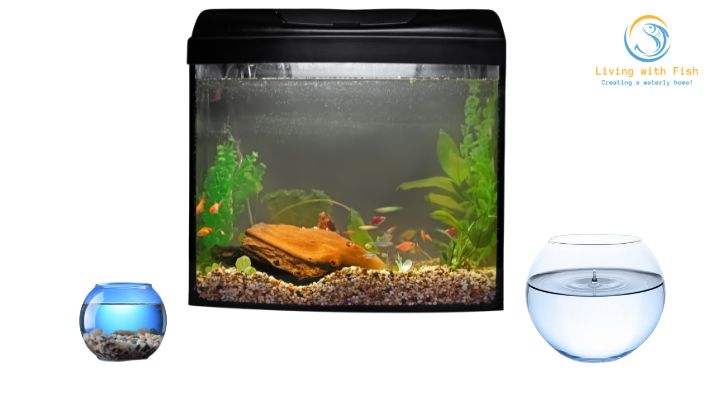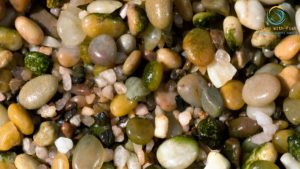This article covers the following areas –
- Consider the Type of Fish You Want to Keep
- Determine the Space You Have Available
- Set Your Budget
- Choose a Tank Shape
- Consider Tank Material
- Consider the Fish Tank’s Weight
- Plan for the Future
- In Conclusion
- FAQs: The Ultimate Guide to Choosing the Best Fish Tank Size
When I first decided to get a fish tank, I was overwhelmed by the many choices available. From small desktop aquariums to massive, room-sized tanks, the options seemed endless. But after many years of keeping fish, I’ve learned that the perfect fish tank size depends on a few key factors. In this post, I’ll share everything you need to know to choose the best fish tank size for your needs.
The table below combines all the relevant information related to fish tank sizes, including dimensions and budget estimates.
| Tank Size | Dimensions (inches) | Total Estimated Budget (USD) |
|---|---|---|
| 5 gallons | 16 x 8 x 10 | 120-180 |
| 10 gallons | 20 x 10 x 12 | 200-280 |
| 20 gallons | 24 x 12 x 16 | 310-470 |
| 30 gallons | 36 x 12 x 16 | 410-600 |
| 50 gallons | 36 x 18 x 19 | 650-1,000 |
| 75 gallons | 48 x 18 x 21 | 900-1,425 |
| 100 gallons | 72 x 18 x 21 | 1,200-2,000 |
This table can help you guide your decision-making process when selecting a fish tank size. Remember that these values are approximate and may vary depending on the specific materials, equipment, and fish species you choose for your aquarium. Now, let’s learn in detail about all the considered factors in choosing an appropriate fish tank size.
Consider the Type of Fish You Want to Keep
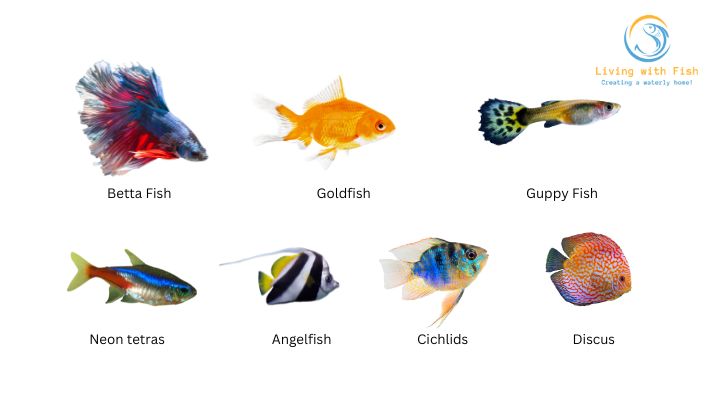
Different fish species have unique requirements when it comes to tank size. It’s crucial to understand these needs to ensure your fish have a healthy, happy environment. Providing more space than the minimum tank size is always beneficial for your fish’s well-being.
In the table below, I’ve outlined the minimum tank sizes for some common fish types, as well as additional information about their habitat preferences, social behavior, and compatibility with other fish species.
| Fish Type | Minimum Tank Size | Preferred Habitat | Social Behavior | Compatibility with Other Fish |
|---|---|---|---|---|
| Betta fish | 5 gallons | Calm, planted environment | Solitary | Low; avoid fin-nippers |
| Goldfish | * 20 gallons for 1 fish * 10 gallons for each additional | Cool, well-oxygenated water | Social | Moderate; avoid small fish |
| Guppies | 10 gallons | Planted, warm water | Social | High; peaceful community fish |
| Neon tetras | 10 gallons | Dimly lit, planted | Schooling | High; peaceful community fish |
| Angelfish | 20 gallons | Tall, planted tank | Semi-aggressive | Moderate; avoid small fish |
| Cichlids | 30 gallons | Rocky, structured habitat | Territorial | Low; species-specific tanks |
| Discus | 50 gallons | Warm, soft water | Schooling | Moderate; avoid aggressive fish |
Let’s dive deeper into each fish type.
#1 Betta fish
These beautiful, small fish are often seen in tiny bowls or vases, but they require at least 5 gallons to thrive. Bettas appreciate a calm, planted environment with places to hide. They are solitary fish and can be aggressive towards other bettas or fish with long, flowing fins.
#2 Goldfish
Goldfish are social fish that grow quite large, so they need plenty of space. One goldfish requires a minimum of 20 gallons, with an additional 10 gallons for each extra goldfish. They prefer cooler, well-oxygenated water and can be housed with other similarly sized, non-aggressive fish species.
#3 Guppies
Guppies are small, colorful, and peaceful fish, making them perfect for community tanks. They thrive in a 10-gallon or larger tank with plenty of live plants. Guppies are compatible with other peaceful, similarly-sized fish species.
#4 Neon tetras
These small, schooling fish love dimly lit, planted tanks. They require a minimum of 10 gallons and are happiest in groups of 6 or more. Neon tetras are peaceful and can be kept with other community fish.
#5 Angelfish
Angelfish are semi-aggressive and need at least 20 gallons of space, with a preference for tall, planted tanks. They can be territorial, so it’s best to avoid housing them with small fish that they might see as prey.
#6 Cichlids
Cichlids are diverse and come in many different shapes and sizes. A 30-gallon tank is the minimum for most species, but some larger cichlids may require even more space. These territorial fish typically do best in species-specific tanks or with other robust, similarly-sized fish.
#7 Discus
Discus are large, colorful, and sensitive fish that need pristine water conditions. They require at least 50 gallons, prefer warm, soft water, and do well in groups. Discus can be housed with other peaceful, non-aggressive fish species that share similar water requirements but avoid adding fish that may compete for food or become too boisterous.
Determine the Space You Have Available
Before you decide on a fish tank size, it’s essential to consider where you’ll place the aquarium. Measure the available space and ensure you have a sturdy surface to support the weight of the filled tank. When planning the location of your fish tank, consider the following factors:
(1) Surface Strength
Ensure that the surface where you plan to place the tank is sturdy and capable of supporting its filled weight. This may include a dedicated aquarium stand, a strong table, or a reinforced shelf.
(2) Floor Load Capacity
Consider the load capacity of your floor, particularly if you’re placing a large tank on an upper level of your home. Consult with a structural engineer if you’re unsure whether your floor can support the weight of a large aquarium.
(3) Accessibility
Place your tank in a location that provides easy access for maintenance tasks such as water changes, filter cleaning, and feeding. Make sure there is enough space around the tank to accommodate equipment such as heaters, filters, and lighting.
(4) Stability
Ensure the surface where you place the tank is level and free from vibrations. An uneven surface can cause stress on the tank’s seams and increase the risk of leaks or cracks, while vibrations from nearby appliances or foot traffic can stress your fish.
Common Fish Tank Dimensions
Understanding the dimensions of your fish tank is important for planning the tank’s placement and ensuring you have enough space for the necessary equipment. The table below shows the dimensions of common fish tank sizes in inches.
| Tank Size | Dimensions (inches) |
|---|---|
| 5 gallons | 16 x 8 x 10 |
| 10 gallons | 20 x 10 x 12 |
| 20 gallons | 24 x 12 x 16 |
| 30 gallons | 36 x 12 x 16 |
| 50 gallons | 36 x 18 x 19 |
| 75 gallons | 48 x 18 x 21 |
| 100 gallons | 72 x 18 x 21 |
Set Your Budget
Fish tanks can range in price from around $50 for a small, basic setup to several thousand dollars for large, custom-built aquariums. Consider how much you will spend on the tank and the necessary equipment, decorations, and fish.
A larger tank may be more expensive initially, but it can save you money in the long run by providing a more stable environment and reducing the need for frequent water changes.
The table below provides an approximate budget for various fish tank sizes. Remember that the costs can vary depending on the materials, brand, and additional equipment or decorations you choose. Use this table as a starting point to help you plan your fish tank budget.
| Tank Size | Tank Cost (USD) | Equipment & Decorations (USD) | Fish Cost (USD) | Total Estimated Budget (USD) |
|---|---|---|---|---|
| 5 gallons | 50 | 60-100 | 10-30 | 120-180 |
| 10 gallons | 80 | 100-150 | 20-50 | 200-280 |
| 20 gallons | 120 | 150-250 | 40-100 | 310-470 |
| 30 gallons | 150 | 200-300 | 60-150 | 410-600 |
| 50 gallons | 250 | 300-500 | 100-250 | 650-1,000 |
| 75 gallons | 350 | 400-700 | 150-375 | 900-1,425 |
| 100 gallons | 500 | 500-1,000 | 200-500 | 1,200-2,000 |
Remember to account for ongoing maintenance costs, such as fish food, water treatments, and replacement equipment, when setting your budget. Also, consider that a larger tank may have a higher initial cost, but it can save you money in the long run by providing a more stable environment and reducing the need for frequent water changes.
Choose a Tank Shape
Fish tanks come in various shapes, from traditional rectangular aquariums to bowfront, hexagonal, and even cylindrical designs. The shape of the tank can affect both its aesthetic appeal and the swimming space available for your fish.
Rectangular tanks are the most common and offer the most efficient use of space. However, other shapes can create visual interest and provide unique swimming areas for your fish. Remember that some tank shapes may require specialized equipment, such as custom-built stands or lighting.
Consider Tank Material
When choosing the material for your fish tank, it’s important to consider the pros and cons of the materials. Fish tanks are usually made of glass or acrylic. Both materials have unique advantages and disadvantages that can impact your fishkeeping experience.
Glass Tanks
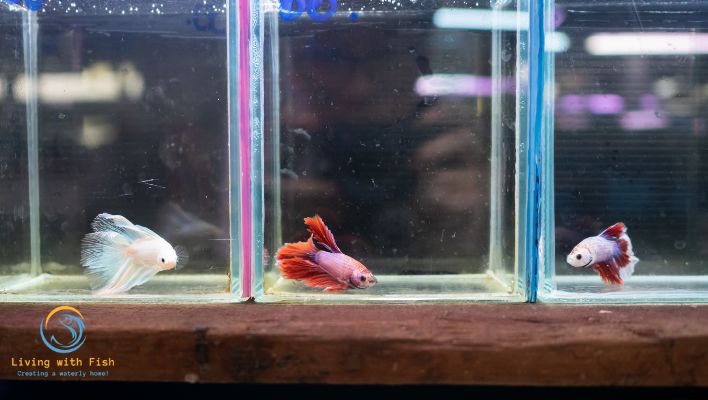
Pros:
- Cost: Glass tanks are generally less expensive than acrylic tanks, making them an attractive option for budget-conscious fishkeepers.
- Scratch Resistance: Glass is less prone to scratches than acrylic, ensuring that your tank maintains its clarity over time.
- Clarity: Glass offers better clarity than acrylic, allowing you to view your fish and plants in sharp detail.
- Resistance to Warping: Glass tanks are less likely to warp over time, ensuring that the tank remains structurally sound and retains its original shape.
- Chemical Resistance: Glass is more resistant to chemicals, which can be beneficial when treating your tank with medications or other additives.
Cons:
- Weight: Glass tanks are heavier than acrylic tanks, making them more challenging to move or relocate.
- Fragility: Glass is more fragile and prone to breaking, particularly during transport or if accidentally hit by a hard object.
- Limited Shapes: Glass tanks are typically limited to more traditional, rectangular shapes due to the nature of the material.
Acrylic Tanks
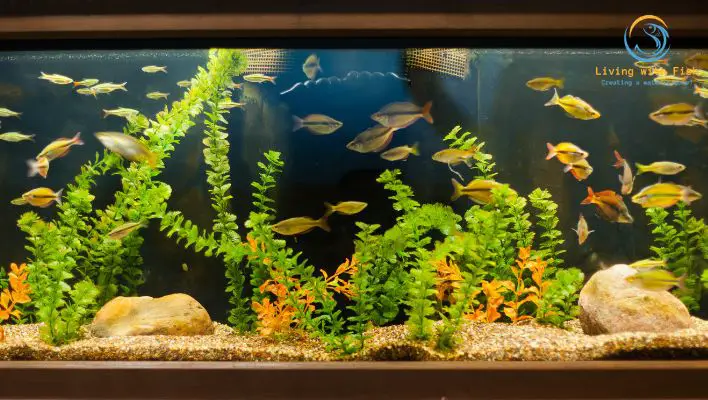
Pros:
- Lightweight: Acrylic tanks are lighter than glass tanks, making them easier to transport and move around your home.
- Durability: Acrylic is more durable and less likely to break than glass, making it a safer option if you have young children or pets.
- Variety of Shapes: Acrylic can be molded into various shapes, allowing for more unique and visually interesting tank designs.
- Insulation: Acrylic offers better insulation than glass, which can help maintain a stable water temperature in your tank.
Cons:
- Cost: Acrylic tanks are more expensive than glass tanks, which may concern budget-conscious fishkeepers.
- Scratch Susceptibility: Acrylic is more prone to scratches, impacting the tank’s clarity and appearance over time.
- Yellowing: Over time, acrylic tanks may develop a slight yellowing, which can affect the overall appearance and clarity of the tank.
Consider the Fish Tank’s Weight
The weight of a filled fish tank is an essential factor to consider when selecting a tank size and planning its placement. Water weighs approximately 8.34 pounds per gallon, which means even small tanks can become quite heavy once filled with water, substrate, and decorations. It’s crucial to ensure that the surface where you plan to place your tank can support its weight to prevent damage or accidents.
The table below shows the approximate filled weight of common fish tank sizes, including water, substrate, and decorations. Remember that these weights are approximate and may vary depending on the specific materials used in your tank setup.
| Tank Size | Water Weight (lbs) | Substrate Weight (lbs) | Decorations Weight (lbs) | Approximate Filled Weight (lbs) |
|---|---|---|---|---|
| 5 gallons | 42 | 10 | 10 | 62 |
| 10 gallons | 83 | 15 | 13 | 111 |
| 20 gallons | 167 | 25 | 33 | 225 |
| 30 gallons | 250 | 35 | 63 | 348 |
| 50 gallons | 417 | 50 | 133 | 600 |
| 75 gallons | 625 | 75 | 150 | 850 |
| 100 gallons | 834 | 100 | 266 | 1,200 |
Remember that the weights of substrate and decorations can vary significantly depending on the type and quantity used in your aquarium. For example, a heavily planted tank with large rocks and driftwood will weigh more than a sparsely decorated tank with just a few small ornaments.
Always take the specific materials used in your tank setup into account when estimating the filled weight and ensure that the chosen surface can safely support the load.
Plan for the Future
When choosing a fish tank size, it’s essential to think about your future plans. Do you plan to add more fish or upgrade to a larger tank eventually? If so, it might be worth investing in a larger tank from the start. This will save you the hassle of having to transfer your fish and set up a new tank later on.
On the other hand, if you’re unsure about your long-term commitment to fishkeeping or have limited space, starting with a smaller tank might be a better option.
In Conclusion
Choosing the best fish tank size for your needs can seem overwhelming, but by considering the type of fish you want to keep, the space you have available, your budget, tank shape, material, weight, and future plans, you can make an informed decision.
Remember that providing your fish with a spacious and well-maintained environment will help ensure their health and happiness. Happy fishkeeping!
I hope this ultimate guide to choosing the best fish tank size has been helpful for you! Please feel free to leave a comment below with any questions, suggestions, or experiences you’d like to share.
Happy fishkeeping!
FAQs: The Ultimate Guide to Choosing the Best Fish Tank Size
1. Why does tank size matter when keeping fish?
The size of the tank directly affects the well-being of the fish. A larger volume provides more stable water parameters, reduces stress, and gives fish adequate space to swim and grow.
2. I’m a beginner. What tank size should I start with?
For beginners, a tank between 20 to 30 gallons is often recommended. This size is manageable yet provides a more forgiving environment regarding water quality and stability.
3. Can I keep goldfish in a bowl?
Contrary to popular belief, goldfish require a lot of space due to their potential size and waste production. A bowl is not suitable; a minimum of 20 gallons for the first goldfish and an additional 10 gallons for each one after is recommended.
4. How many fish can I keep in my tank?
A general guideline is one inch of fish per gallon of water. However, this can vary based on the species and their specific needs. Always research each fish’s requirements.
5. Is it easier to maintain a larger or smaller tank?
Larger tanks can be more stable regarding water parameters, making them easier to maintain in that aspect. However, they might require more time during water changes and cleaning. Smaller tanks can fluctuate more in water quality but are quicker to clean and maintain.
6. Does the shape of the tank affect how many fish I can keep?
Yes, the surface area is crucial for oxygen exchange. For instance, a long tank may be more suitable than a tall one of the same volume, as it offers more surface area.
7. What’s the difference between gallons and liters for measuring tank size?
Gallons are used in the US customary system, while liters are a metric measurement. There are about 3.785 liters in a US gallon. Always check which measurement is being used in guidelines or product specifications.
8. Can I upgrade to a larger tank in the future?
Absolutely! If you find that your fish need more space or you want to add more, upgrading to a larger tank is a great option. Just ensure you properly cycle the new tank before transferring your fish.
9. How do I know if my tank is overcrowded?
Signs of overcrowding include decreased water quality, increased aggression or stress in fish, insufficient hiding spots, and rapid oxygen depletion. It’s essential to monitor your tank regularly for these signs.
10. Are there any tools or calculators to help determine the right tank size?
Yes, several online calculators can recommend tank sizes based on the fish species you intend to keep. Always consider these as guidelines and do further research to ensure the well-being of your aquatic pets.

